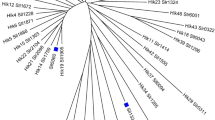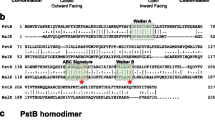Abstract
The gene products of sll0337 and slr0081 in Synechocystis sp. PCC 6803 have been identified as the homologues of the Escherichia coli phosphate-sensing histidine kinase PhoR and response regulator PhoB, respectively. Interruption of sll0337, the gene encoding the histidine protein kinase, by a spectinomycin-resistance cassette blocked the induction of alkaline phosphatase activity under phosphate-limiting conditions. A similar result was obtained when slr0081, the gene encoding the response regulator, was interrupted with a cassette conferring resistance to kanamycin. In addition, the phosphate-specific transport system was not up-regulated in our mutants when phosphate was limiting. Unlike other genes for bacterial phosphate-sensing two-component systems, sll0337 and slr0081 are not present in the same operon. Although there are three assignments for putative alkaline phosphatase genes in the Synechocystis sp. PCC 6803 genome, only sll0654 expression was detected by northern analysis under phosphate limitation. This gene codes for a 149 kDa protein that is homologous to the cyanobacterial alkaline phosphatase reported in Synechococcus sp. PCC 7942 [Ray, J.M., Bhaya, D., Block, M.A. and Grossman, A.R. (1991) J. Bact. 173: 4297–4309]. An alignment identified a conserved 177 amino acid domain that was found at the N-terminus of the protein encoded by sll0654 but at the C-terminus of the protein in Synechococcus sp. PCC 7942.
Similar content being viewed by others
References
Aiba, H., Nagaya, M. and Mizuno, T. 1993. Sensor and regulator proteins from the cyanobacterium Synechococcus species PCC7942 that belong to the bacterial signal-transduction protein families: implication in the adaptive response to phosphate limitation. Mol. Microbiol. 8: 81–91
Au, S., Roy, K.L. and von Tigerstrom, R.G. 1991. Nucleotide sequence and characterization of the gene for secreted alkaline phosphatase from Lysobacter enzymogenes. J. Bact. 173: 4551–4557.
Bartsevich, V.V. and Shestakov, S.V. 1995. The dspA gene product of the cyanobacterium Synechocystis sp. strain PCC 6803 influences sensitivity to chemically different growth inhibitors and has amino acid similarity to histidine protein kinases. Microbiology 141: 2915–2920.
Bleecker, A.B. 1999. Ethylene perception and signaling: an evolutionary perspective. Trends Plant Sci. 4: 269–274.
Chang, C.N., Kuang, W.J. and Chen, E.Y. 1986. Nucleotide sequence of the alkaline phosphatase gene of Escherichia coli. Gene 44: 121–125.
Dziejman, M. and Mekalanos, J.J. 1995. Two-component signal transduction and its role in the expression of bacterial virulence factors. In: J.A. Hoch and T.J. Silhavy (Eds.) Two-Component Signal Transduction, American Society for Microbiology, Washington, D.C., pp. 305–317.
Grigorieva, G. and Shestakov, S. 1982. Transformation in the cyanobacterium Synechocystis sp. 6803. FEMS Microbiol. Lett. 13: 367–370.
Hughes, J., Lamparter, T., Mittmann, F., Hartmann, E., Gartner, W., Wilde, A. and Borner, T. 1997. A prokaryotic phytochrome. Nature 386: 663.
Kakimoto, T. 1996. CKI1, a histidine kinase homolog implicated in cytokinin signal transduction. Science 274: 982–985.
Kaneko, T., Sata, S., Kotani, H., Tanaka, A., Asamizu, E., Nakamura, Y., Miyajima, N., Hirosawa, M., Sugiura, M., Sasamoto, S., Kimura, T., Hosouchi, T., Matsuno, A., Mu-raki, A., Nakazaki, N., Naruo, K., Okumura, S., Shimpo, S., Takaeuchi, C., Wada, T., Watanabe, A., Yamada, M., Yasuda, M. and Tabata, S. 1996. Sequence analysis of the genome of the unicellular cyanobacterium Synechocystis sp. strain PCC6803. II. Sequence determination of the entire genome and assignment of potential protein-coding regions. DNA Res. 3: 109–136.
Kondo, H., Nakagawa, A., Nishihira, J., Nishimura, Y., Mizuno, T. and Tanaka, I. 1997. Eschericha coli positive regulator OmpR has a large loop structure at the putative RNA polymerase interaction site. Nature Struct. Biol. 4: 28–31.
Lamparter, T., Mittmann, F., Gartner, W., Borner, T., Hartmann, E. and Hughes, J. 1997. Characterization of recombinant phytochrome from the cyanobacterium Synechocystis. Proc. Natl. Acad. Sci. USA 94: 11792–11797.
Lee, T., Makino, K., Shinagawa, H., Amemura, M. and Nakata, A. 1989. Phosphate regulon in members of the family Enterobacteriaceae: comparison of the phoB-phoR operons of Escherichia coli, Shigella dysenteriae,andKlebsiella pneumoniae. J. Bact. 171: 6593–6599.
Makino, K., Amemura, M., Kim, S.K., Nakata, A. and Shina-gawa, H. 1994. Mechanism of transcriptional activation of the phosphate regulon in Escherichia coli. In: A. Torriani-Gorini, E. Yagil and S. Silver (Eds.) Phosphate in Microorganisms: Cellular and Molecular Biology, American Society for Microbiology, Washington, D.C., pp. 5–12.
Makino, K., Amemura, M., Kawamoto, T., Kimura, S., Shinagawa, H., Nakata, A. and Suzuki, M. 1996. DNA binding of PhoB and its interaction with RNA polymerase. J. Mol. Biol. 259: 15–26.
Mizuno, T., Kaneko, T. and Tabata, S. 1996. Compilation of all genes encoding bacterial two-component signal transducers in the genome of the cyanobacterium, Synechocystis sp. strain PCC 6803. DNA Res. 3: 407–414.
Mohamed, A. and Jansson, C. 1989. Influence of light on accumulation of photosynthesis-specific transcripts in the cyanobacterium Synechocystis 6803. Plant Mol. Biol. 13: 693–700.
Morgan, T.R., Shand, J.A., Clarke, S.M. and Eaton-Rye, J.J. 1989. Specific requirements for cytochrome c-550 and the manganese-stabilizing protein in photoautotrophic strains of Synechocystis sp. PCC 6803 with mutations in the domain Gly-351 to Thr-436 of the chlorophyll-binding protein CP47. Biochemistry 37: 14437–14449.
Nagaya, M., Aiba, H. and Mizuno, T. 1994. The sphR product, a two-component system response regulator protein, regulates phosphate assimilation in Synechococcus sp. strain PCC 7942 by binding to two sites upstream from the phoA promoter. J. Bact. 176: 2210–2215.
Oka, A., Sugisake, H. and Takanami, M. 1981. Nucleotide sequence of the kanamycin-resistance transposon Tn 903. J. Mol. Biol. 147: 217–226.
Okamura, H., Hanaoka, S., Nagadoi, A., Makino, K. and Nishimura, Y. 2000. Structural comparison of the PhoB and OmpR DNA-binding/transactivation domains and the arrangement of PhoB molecules on the phosphate box. J. Mol. Biol. 295: 1225–1236.
Parkinson, J.S. and Kofoid, E.C. 1992. Communication modules in bacterial signaling proteins. Annu. Rev. Genet. 26: 71–112.
Pratt, L. and Silhavy, T. 1994. OmpR mutants specifically defective for transcriptional activation. J. Mol. Biol. 243: 579–594.
Prentki, P. and Krisch, H.M. 1984. In vitro insertional mutagenesis with a selectable DNA fragment. Gene 29: 303–313.
Ray, J.M., Bhaya, D., Block, M.A. and Grossman, A.R. 1991. Isolation, transcription, and inactivation of the gene for an atypical alkaline phosphatase of Synechococcus sp. strain PCC 7942. J. Bact. 173: 4297–4309
Stock, A.M., Mottonen, J.M., Stock, J.B. and Schutt, C.E. 1989. Three-dimensional structure of CheY, the response regulator of bacterial chemotaxis. Nature 337: 745–749.
Stock, J.B., Surette, M.G., Kevit, M. and Park, P. 1995. Two-component signal transduction systems: structure-function relationships and mechanisms of catalysis. In: J.A. Hoch and T.J. Silhavy (Eds.) Two-Component Signal Transduction, American Society for Microbiology, Washington, D.C., pp. 25–51.
Surin, B.P., Rosenberg, H. and Cox, G.B. 1985. Phosphate-specific transport system of Escherichia coli: nucleotide sequence and gene-polypeptide relationship. J. Bact. 161: 189–198.
Suzuki, I., Los, D.A., Kanesaki, Y., Mikami, K. and Murata, N.2000. The pathway for perception and transduction of low-temperature signals in Synechocystis. EMBO J. 19: 1327–1334.
Torriani-Gorini, A. 1994. Introduction: the Pho regulon of Escherichia coli. In: A. Torriani-Gorini, E. Yagil and S. Silver (Eds.) Phosphate in Microorganisms: Cellular and Molecular Biology, American Society for Microbiology, Washington, D.C., pp. 1–4.
Volz, K. 1995. Structural and functional conservation in response regulators. In: J.A. Hoch and T.J. Silhavy (Eds.) Two-Component Signal Transduction, American Society for Microbiology, Washington, D.C., pp. 53–64.
Wanner, B.L. 1992. Is cross regulation by phosphorylation of two-component response regulator proteins important in bacteria? J. Bact. 174: 2053–2058.
Wanner, B.L. 1996. Phosphorus assimilation and control of the phosphate regulon. In: F.C. Neidhard (Ed.) Escherichia coli and Salmonella: Cellular and Molecular Biology, American Society for Microbiology, Washington, D.C., Vol. 1, pp. 1357–1381.
Wanner, B.L. and Wilmes-Riesenberg, M.R. 1992. Involvement of phosphotransacetylase, acetate kinase, and acetyl phosphate synthesis in control of the phosphate regulon in Escherichia coli. J. Bact. 174: 2124–2130.
Wanner, B.L., Wilmes, M.R. and Young, D.C. 1988. Control of bacterial alkaline phosphatase synthesis and variation in an Escherichia coli K-12 phoR mutant by adenyl cyclase, the cyclic AMP receptor protein, and the phoM operon. J. Bact. 170: 1092–1102.
Watson, G.M.F., Scanlan, D.J. and Mann, N.H. 1996. Characterization of the genes encoding a phosphate-regulated two component sensory system in the marine cyanobacterium Synechococcus sp. WH7803. FEMS Microbiol. Lett. 142: 105–109.
Wilde, A., Churin, Y., Schubert, H. and Borner, T. 1997. Disruption of a Synechocystis sp. PCC 6803 gene with partial similarity to phytochrome genes alters growth under changing light qualities. FEBS Lett. 406: 89–92.
Williams, J.G.K. 1988. Construction of specific mutations in the photosystem II photosynthetic reaction center by genetic engineering methods in the cyanobacterium Synechocystis 6803. Meth. Enzymol. 167: 766–778.
Yeh, K.C., Wu, S.H., Murphy, J.T. and Lagarias, J.C. 1997. A cyanobacterial phytochrome two-component light sensory system. Science 277: 1505–1507.
Author information
Authors and Affiliations
Rights and permissions
About this article
Cite this article
Hirani, T.A., Suzuki, I., Murata, N. et al. Characterization of a two-component signal transduction system involved in the induction of alkaline phosphatase under phosphate-limiting conditions in Synechocystis sp. PCC 6803. Plant Mol Biol 45, 133–144 (2001). https://doi.org/10.1023/A:1006425214168
Issue Date:
DOI: https://doi.org/10.1023/A:1006425214168




